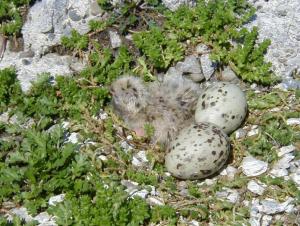

This article was developed from a University at Buffalo press release.
Professor and researcher Alicia Pérez-Fuentetaja recently published another paper stemming from the Emerald Shiner Project. The new paper, done with co-authors Steven Travis and Diana Aga from University at Buffalo, features work on the amount of legacy persistent organic pollutants (POPs) in various life stages of the common tern (Sterna hirundo) in the Niagara River. Though they are migratory, common terns breed in the Niagara River corridor and a main component of their diet is emerald shiners (Notropis atherinoides).
“The common tern is a threatened species in New York State, and their numbers have not increased much despite state efforts to provide nesting sites and surveillance. This study shows how wildlife is affected by human pollution of aquatic systems and how the chemicals we produce can have a multigenerational effect, being passed from mothers to chicks,” said Dr. Pérez-Fuentetaja in a UB press release.
This study looked at the concentration of PCBs, PBDEs, and DDE, a metabolite of the insecticide DDT, in common terns at various life stages and in their food source, emerald shiners. PCBs and DDT were banned in the 1970s and PBDEs haven’t been sold in the US since 2013, yet they persist in the environment and bioaccumulate up the food web. This study found that newly hatched chicks had the highest concentrations of POPs, and the source of these chemicals was passed to them solely through maternal loading since they hadn’t eaten yet. Older chicks had a decrease of chemicals as they grew and began to metabolize some of the chemicals. There was also a match between emerald shiner contaminant profiles and those of tern brains and livers.
“These substances interfere with the reproductive system and are endocrine disruptors,” Dr. Pérez-Fuentetaja said. “They tax the terns’ livers as they have to try and get rid of these pollutants, but the bioaccumulative nature of PCBs, PBDEs and DDEs means that the birds will not be able to fully detoxify themselves, and that they will pass part of their body-load to the next generation. These substances can alter development and neurological processes and could cause deformities, cancers, and impaired behavior.”
The paper, Evidence of continued exposure to legacy persistent organic pollutants in threatened migratory common terns nesting in the Great Lakes, was published online in Environment International on September 3 and in the journal’s November issue. All of the birds in the study died naturally by weather events and were collected by the NYS Department of Environmental Conservation.
Image caption: Above: A 1-3 day-old tern chick and eggs in a nest.
Some content on this page is saved in PDF format. To view these files, download Adobe Acrobat Reader free. If you are having trouble reading a document, request an accessible copy of the PDF or Word Document.
